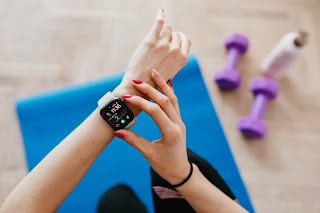Wearable health and fitness technology has become increasingly popular in recent years, offering individuals the ability to track and manage various aspects of their well-being. These devices typically come in the form of smartwatches, fitness trackers, and other wearables equipped with sensors and connectivity features. Here are some key aspects and types of wearable health and fitness tech:
 |
| Smartwatches |
- Fitness Trackers:
- Functionality: These devices primarily track physical activity, such as steps taken, distance traveled, calories burned, and sometimes even sleep patterns.
- Sensors: Accelerometers and gyroscopes are commonly used to detect movement and orientation.
- Smartwatches:
- Multifunctional: In addition to fitness tracking, smartwatches often provide smartphone notifications, heart rate monitoring, GPS tracking, and other features.
- Health Monitoring: Some smartwatches include more advanced health monitoring capabilities, such as electrocardiogram (ECG) readings and blood oxygen level measurement.
- Heart Rate Monitors:
- Continuous Monitoring: Wearables with heart rate monitoring capabilities provide real-time data during exercise and rest, offering insights into cardiovascular health.
- Variability Analysis: Some devices analyze heart rate variability (HRV) to assess stress levels and recovery.
- Sleep Trackers:
- Sleep Patterns: Wearables equipped with sleep tracking capabilities monitor the duration and quality of sleep, providing insights to improve sleep habits.
- Sleep Staging: Advanced devices can categorize sleep into different stages (light, deep, REM) for more detailed analysis.
- GPS-enabled Devices:
- Location Tracking: Wearables with GPS can track outdoor activities, providing information on routes taken, distance covered, and elevation changes.
- Mapping and Navigation: Some devices offer mapping and navigation features for activities like running or biking.
- Nutrition and Calorie Trackers:
- Diet Monitoring: Certain wearables allow users to input and track their dietary habits, providing information on calorie intake and nutritional content.
- Hydration Tracking: Some devices remind users to stay hydrated and monitor water intake.
- Wearables for Medical Monitoring:
- Blood Pressure Monitors: Some wearables include blood pressure monitoring features for individuals with hypertension or other cardiovascular conditions.
- Glucose Monitoring: There are wearables designed for continuous glucose monitoring for individuals with diabetes.
- Biofeedback Devices:
- Stress Management: Wearables may include features for stress management, such as guided breathing exercises and stress level monitoring.
- Mindfulness and Meditation: Some devices encourage mindfulness and meditation practices for overall well-being.
- Social and Gamification Features:
- Community Engagement: Many wearable apps allow users to connect with friends, join challenges, and share their progress.
- Gamification: Adding game-like elements, such as badges and rewards, can motivate users to stay active and achieve their fitness goals.
As technology continues to advance, we can expect more sophisticated and integrated features in wearable health and fitness tech, further empowering individuals to take control of their health and well-being.








0 Comments